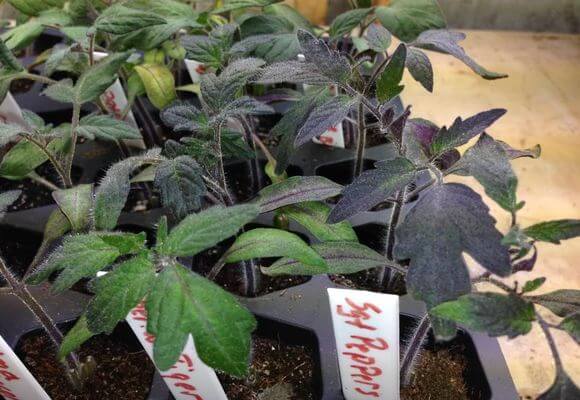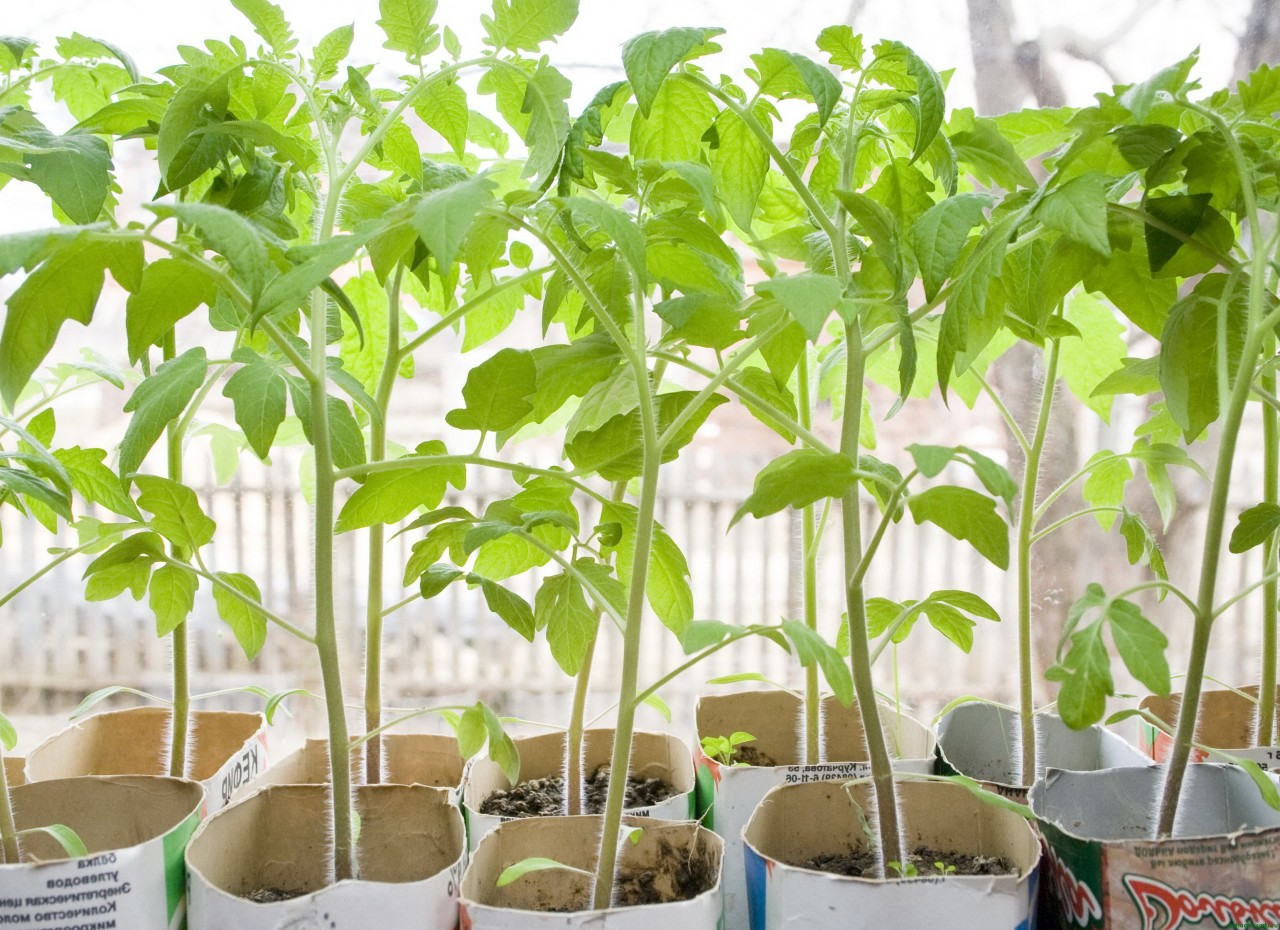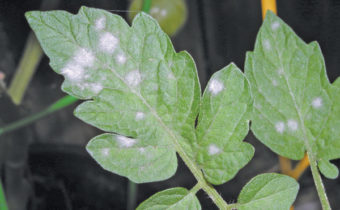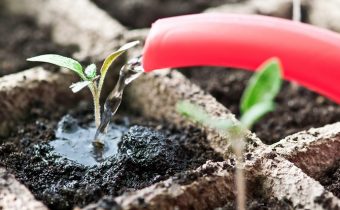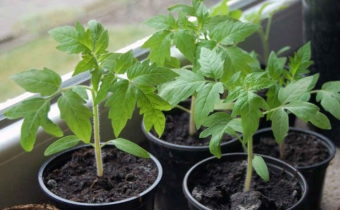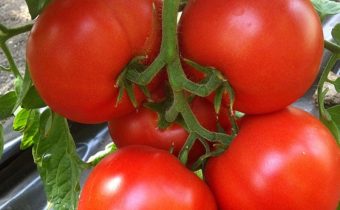Tomato seedling thin and long, what to do?

Many gardeners and growers prefer to grow tomato seedlings on their own, without relying on market traders who, under a well-known variety, can sell what is unknown. But not always these actions end in success. In some cases, immediately after germination, the shoots do not look the best: they are frail, thin and pale. This happens, most often, due to errors made at the very beginning of growing seedlings.
Reasons for pulling seedlings
Pulling sprouted tomato sprouts is not the result of buying a bad variety or defective seeds, but as a result of careless or inept actions of the gardener. The reason for this is:
- Sowing seeds too often. Seedlings are weak and thin due to too many sprouts per unit area. Because of this, there is a shortage of land, food, watering.
- Bad light. There is a struggle between the shoots for sunlight and the seedlings are drawn too much.
- Filling seedlings with water. Watering of tomatoes should be as the earthen coma dries, not more often than 1 time in 7 days, otherwise the shoots become pale and thin.
- Overfeeding with nitrogen. Excessive amount of fertilizer implies a reduction in the quality of the grown seedlings.
- The seedling is not on time. Young sprouts of tomatoes are seated in different containers after the appearance of 2-3 true leaves. If the gardener is late with this procedure or, unknowingly, neglects it, he cannot grow good seedlings.
Ways to restrain young plants:
- Before sprouting the seeds, the temperature in the room is maintained at about 25 degrees, after the appearance of sprouts it is lowered to 17, after 20 days it is slightly raised to stimulate the growth of plants.
- Proper lighting plays a big role in plant development. In February and until the end of March, tomatoes need to be illuminated for 15-16 hours.
- When picking up sprouting seedlings, seven-lobed leaves are removed, and the sprout is deepened to a greater depth, spreading the ground to the roots. The plant will spend energy on the development of new space and the formation of roots. The growth of the crown part is suspended.
- Making the plants stronger and slightly slowing the rapid growth will help fertilizing nitrogen-containing fertilizers. For feeding take 1 tbsp. water or urea in 10 liters of water, then put the seedlings for a while at a temperature of 8-10 degrees, when the sprouts begin to grow stronger and turn green, the plants return to normal growing mode.
- Capacities with sprouts are often turned by different sides towards the sun, prompting the seedlings to turn to the source of illumination by different sides and spend forces on this, and not on rapid growth.
- Planting is restrained by another picking, done when the seedlings grow to 15-20 cm. The tomato throws all its strength to recuperate and stops stretching.
- Removal of cotyledon leaves in turn, the growth of tomatoes is suspended, the trunk is being strengthened.
To restrain the growth of plants helps an unusual way. When you touch the leaves with a hand, a tomato secretes ethylene, which stops its growth.
Proper seedling growing
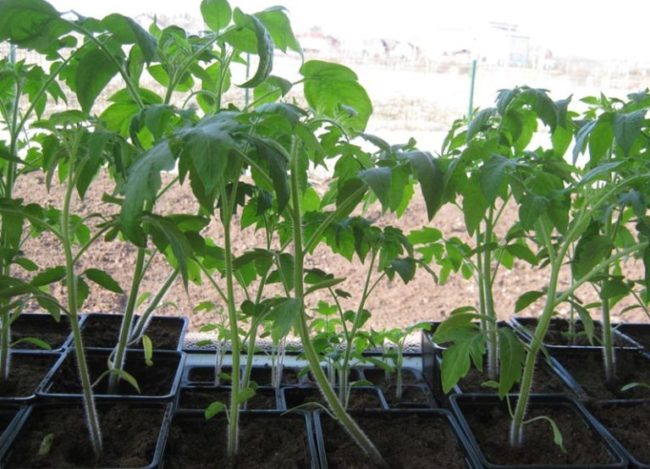
In boxes and pots with soil prepared for planting, make grooves at a distance of 1.5 - 2 cm from each other. They are placed in them, without bothering the seeds of tomatoes, making gaps of 1 cm. Sprinkled with earth, sprinkled from the spray gun with warm water and sent to a warm place for 5-7 days. As soon as the loops appear above the ground, the shelter is removed. The temperature is slightly lowered so that the seedlings do not stretch out.
Sables dive when 2-3 true leaves appear. Weak, sick with small roots reject, leaving only strong and strong plants. After 1.5-2 weeks, feed the full complex fertilizer, watering is done when the earthen coma dries. If the plants develop well, re-feeding is done in a month, if the plants are pale, they are stunted, they give more fertilizer, reducing the recommended dose by half. For 2-3 weeks, tomatoes are prepared for planting at a permanent place. Take out to the sun, starting with 30 minutes, and lower the night temperature to 14-16 degrees. In greenhouses and open ground seedlings are sent, when the soil is heated to 10-15 degrees.
Resuscitation of sprawling seedlings
If the sprouts of tomatoes stretched out before picking as a result of thickening, save them by pinching the upper part, slightly higher than seven-leaf leaves. The stem with the top is placed in water to form the roots, and the lower part is covered with a plastic or glass cup. After about a week, a new leaf will appear on the remaining stem. Thus, from 1 plant receive 2.
Seedlings, reanimated in this way, will yield later than usual.
If the seedlings stretched after picking, use the following rescue methods:
- Chinese method. Let's apply to tall tomatoes. When the seedlings are stretched to 15-20 cm, and before transplanting to the greenhouse, it will not happen soon, the young plant is cut at the root and placed for a short time in the root-forming solution (epine, succinic acid). Appin can be replaced with honey or agave, adding a few drops of aloea or 1 tsp of honey to 200 ml of water, then immediately planted into the ground, vermiculite, coconut substrate in separate cups. Carefully pour the remaining nutrient solution with a root forcing. They are covered with plastic caps and removed from a bright light in a slightly darkened place.
This method will make a tall tomato lower, it does not rest against the greenhouse ceiling with the top, the first brush is near the ground, and not at a height of 50-60 cm. Such stress during growing makes the plants stronger and speeds up the process of bud formation and ripening of fruits.
- Grandma's method. It consists in trimming the trunk not near the ground itself, but depending on the height of the bush. If the plant has greatly overgrown, it can be divided into 3 parts: the top of the head with 1.2 leaves, the middle one with 2-3 leaves and the bottom one with 2-3 leaves. The cut parts are rooted in a wet coconut substrate or placed in a solution of succinic acid, which is the root-forming agent, is used for feeding and restores the microflora of the soil. Before planting, to reduce evaporation of moisture, the leaves are shortened by half. In the solution and the substrate the plants are kept for 3-5 days. After the formation of roots, sprouts are transplanted into separate cups.
A succinating agent is prepared from succinic acid as follows: 1 tablet is finely kneaded with a spoon or pestle in a mortar, dissolved in 100 ml of warm (45-50 degrees) water. Then add water to 500 ml. The solution does not lose its properties for 3 days, then it is poured out or, shortly before the end of the shelf life, it is watered with house plants.
Planting in the greenhouse and soil of stretched tomato seedlings
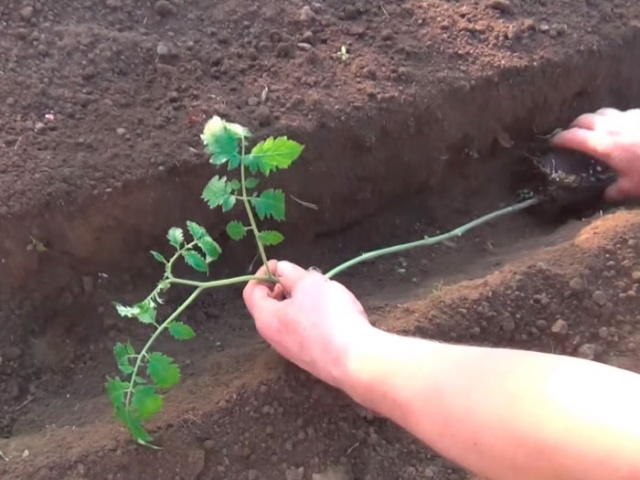
If the young Senets are very long, they are planted in a special way. Procedure:
- In the ground, dig grooves to a depth of 10-15 cm.
- 1.2 lay st.l. superphosphate, a glass of ash, mixed with the ground.
- The method of transshipment is taken out by the stretched plants from the planting tanks.
- Lay the seedlings in the wells with roots to the south, tops to the north.
- Well shed.
- The roots and 2/3 of the trunk are covered with earth, leaving only the top of the head 15-20 cm above the ground.
- Mulch dry earth or humus.
- From above they put the arcs and cover the seedlings from the sun with spanbond.
- In a week, the plants will take root in the ground and grow.
- The grown bushes of tomatoes are tied to pegs.
Further care for tomato bushes does not differ from the usual cultivation of tomatoes.
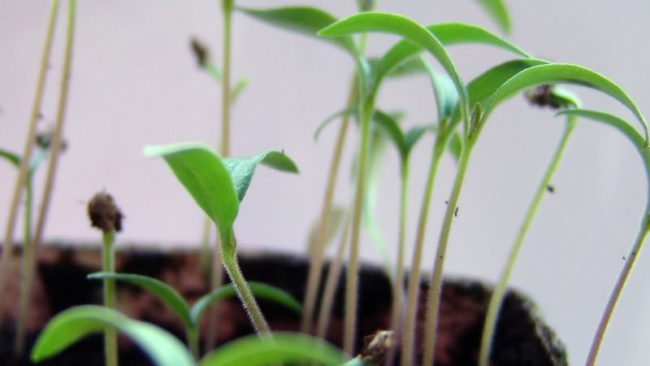
Get all the gardeners want to get large and sweet tomato fruits. For this you need a strong and strong seedlings. It can be grown, following the rules of agrotechnology. But, if the plants are strongly stretched before transplanting into greenhouses and greenhouses, the situation is corrected in several ways. It helps to grow a full-fledged tomato crop.

